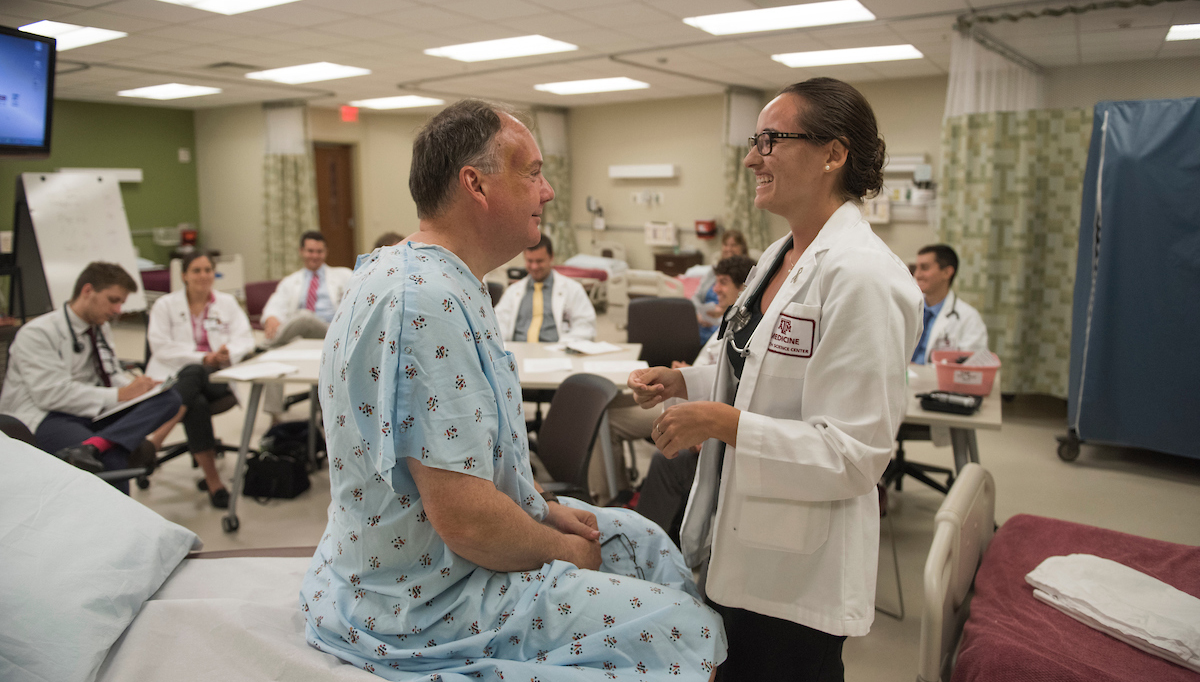Clinical training from the outset

It looks like the control room for a high-tech security-monitoring hub. About 40 different cameras transmit video feeds from about 20 different rooms to these screens. But the people in front of the monitors aren’t security; they’re the faculty at the Texas A&M College of Medicine, and they aren’t looking for shoplifters; they’re recording medical students as they’re tested on their ability to perform a head-to-toe patient exam. And the students aren’t in their third-year, or even in their second: they’re first-year students—and they’re taking their first full-body objective structured clinical examinations (OSCEs) in their first semester of medical school.
For the majority of medical students, their ultimate goal is to see and treat patients and make those patients’ lives better. But often the rigors of medical school and that infamous first year of basic science training and anatomy courses take a toll, making that ultimate goal seem like it’s lost far off in the distance. Studies have shown that purposeful and early exposure to clinical training in medical school makes more prepared and accurate physicians—as well as more engaged students.
So Texas A&M College of Medicine reviewed literature, conducted its own assessment of its students and graduates and came up with a plan. It’s a plan that gets students clinical training sooner than most medical schools. Now, students at Texas A&M begin their clinical training the first week of medical school.
“Our ultimate goal is to create the best physicians possible, and we fully believe this change is the right path to help us do this,” said Jerry Livingston, PhD, director of clinical skills at Texas A&M College of Medicine. “Already we’re seeing first-year students, in their first semester, outperform our expectations on OSCE exams. We couldn’t be happier with what we’re seeing.”
These OSCE exams test clinical skills performance and competence in skills like communication, clinical examination, medical procedures, exercise prescription, joint mobilization and interpretation of results.
First-year students seem happy with the change as well.
“I never believed I’d know what I was looking for in an exam this early on,” said Stav Cullum, a first-year medical student from Lubbock, Texas. “It is so nice to have this education incorporated into our basic science curriculum. It provides motivation and context for what we’re doing. And it has helped me integrate material in other courses—it’s neat to see it all come together.”
Fellow first-year student Sebastian Powell from Houston, Texas agrees. “It’s not just knowing how to do the physical exam, but also the mental shift that has begun to occur at a much earlier stage than I expected,” he said. “Thanks to this exposure, I have begun to organize the information and am able to start piecing together what is relevant, which direction a visit would need to go, etc. All of which is something I never expected to already be able to do or even experience at this point in medical school.”
Students aren’t just being thrown into exam rooms with actual patients—it’s a controlled, simulated environment that they’re prepped for.
“We begin with a week-long ‘bootcamp,’” Livingston said. “We discuss what’s expected professionally and ethically, discuss items like power-of-attorney situations, diversity and inclusion, their own personal health—then we begin helping them learn about the clinical setting. In short, it gives them context and teaches them to talk to patients, not as patients, but as people.”
But this isn’t just any clinical setting: It is a place where students can gain confidence and make mistakes. All clinical training at Texas A&M begins in the state-of-the-art Clinical Learning Resource Center, which is mock clinic, complete with computer-operated mannequins and an entire workforce of real-life standardized patients.
Specially trained “actors” present problems to the students, and it is the students’ job to come up with the correct diagnosis and course of treatment. Then the student’s performance is evaluated and discussed with faculty members, a process that prevents students from being thrown in to an overwhelming situation with a real patient too early.
“We get to experience this as if it were a real situation,” Powell said. “The PETAs [physical exam teaching assistants] take us through the experience on their own bodies. We spend four hours every other week with them to help us learn a new body system—and now I can perform a head-to-toe physical exam.”
Media contact: media@tamu.edu


